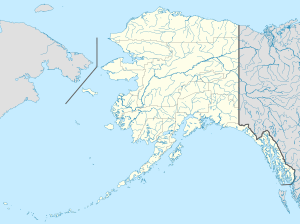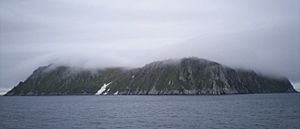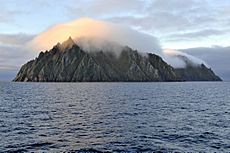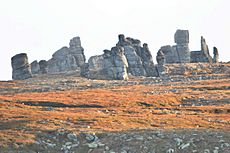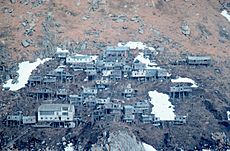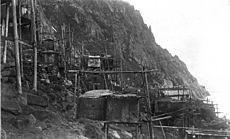King Island (Alaska) facts for kids
King Island (Inupiaq: Ugiuvak) is a small island in the Bering Sea, located west of Alaska. It is about 40 miles (64 km) west of Cape Douglas and south of Wales, Alaska. The island is famous for its unique history and the Inupiat community who once lived there.
Contents
Island Geography and Naming
King Island is a small piece of land in the Bering Sea, off the coast of Alaska. It's about 40 miles (64 km) from the mainland, near the village of Wales, Alaska. The island is only about 1 mile (1.6 km) wide. It has steep slopes on all sides.
The island was named by Captain James Cook in 1778. He was the first European to see the island. He named it after Lieutenant James King, who was part of his exploration team. Today, King Island is part of the Bering Sea unit of the Alaska Maritime National Wildlife Refuge. This means it is a protected area for wildlife.
The King Island People
King Island was once the winter home for a group of about 413 Inupiat. They called themselves Asiuluk, which means "people of the sea." They were also known as Ugiuvaŋmiut, meaning "people of Ugiuvak," which was the village on King Island.
The Ugiuvaŋmiut spent their summers hunting and gathering food. They did this on King Island and on the mainland near where Nome, Alaska is today. In winter, they focused on hunting and fishing on the ice. They hunted seals and walruses. They also caught crabs and collected bird eggs.
Spring and summer were important times for gathering food. Winters were a time for dancing. Because there was little daylight in winter, days were spent dancing. This happened in the "Qagri," which was the men's communal house. For example, the month of December was called Sauyatugvik by the Uġiuvaŋmiut. This means "the time of drumming."
After the town of Nome was built, the islanders began to sell beautiful carvings. They sold these to people in Nome during the summer months.
Moving from King Island
In the mid-1900s, the Bureau of Indian Affairs closed the school on Ugiuvak. This meant the children of Ukivok had to go to school on mainland Alaska. This left the older people and adults on the island to gather food by themselves.
Since the children were not there to help, the adults and elders had to move. They moved to mainland Alaska to make a living. By 1970, all the King Island people had moved off the island permanently.
Even though they moved, the King Islanders have kept their unique culture. They live a life very similar to how they lived on the island. Some King Islanders still go back to the island. They go there to gather traditional foods like walrus and seal.
In 2005 and 2006, the National Science Foundation (NSF) supported a research project. This project brought some King Island natives back to the island. For some, it was their first time back in 50 years.
Population Changes Over Time
| Historical population | |||
|---|---|---|---|
| Census | Pop. | %± | |
| 1880 | 100 | — | |
| 1890 | 200 | 100.0% | |
| 1910 | 119 | — | |
| 1920 | 137 | 15.1% | |
| 1930 | 170 | 24.1% | |
| 1940 | 208 | 22.4% | |
| 1960 | 66 | — | |
| 1980 | 0 | — | |
| 1990 | 0 | — | |
| U.S. Decennial Census | |||
King Island first appeared in the U.S. Census in 1880. It was listed as the native village of "Ookivagamute." In 1890, it was called Ukivok. The island continued to be reported in the census until 1960. After 1960, the population dropped to zero. It has not reported residents since 1990.
Gallery
-
Abandoned stilt village Ugiuvak, photographed 1978. The large white building near the bottom of the slope is the former Bureau of Indian Affairs school.
See also
 In Spanish: Isla del Rey (Alaska) para niños
In Spanish: Isla del Rey (Alaska) para niños


